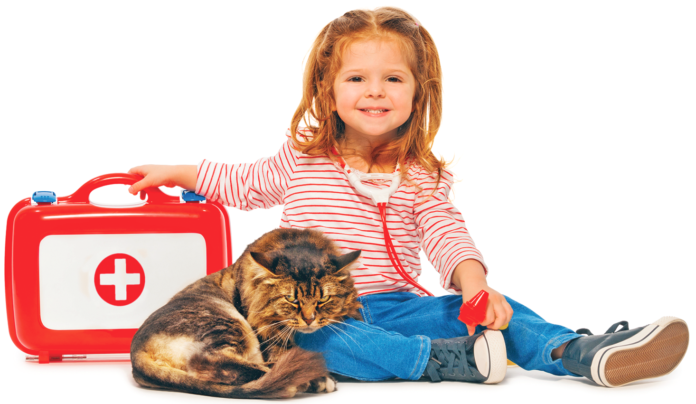A cat lover should be prepared for any minor first aid that her cat may need over her lifetime. Special items may need to be customized for your individual cat (such as extras of any medications she is on), but a basic first aid kit can be started with just 10 items.
A method of restraint is always important. For a cat, a small towel or blanket that she can be wrapped in is ideal. That way you can control paws and mouth if you need to. In addition, many cats calm down once covered. You might also want to include a muzzle for cats or some calming spray such as Feliway (feliway.com).
A digital thermometer is important to check for fever or hypothermia. Ear thermometers work, but the least expensive and most accurate is a digital rectal thermometer. Coat the end with a little petroleum jelly or mineral oil before you insert it to make the process easier on your cat—and you!
Eye wash, the largest bottle you can fit in your kit, is important to include in your kit. You can use it for flushing out a wound as well as an irritated eye or an eye with an obvious foreign body such as plant material.
Antibacterial wound wash choices abound, but chlorhexidine solution is your best bet. You can purchase small containers of wipes with it on them. A wound wash helps you flush out debris such as dirt. If you prefer an iodine scrub, choose a diluted formula, like Betadine (undiluted iodine will burn the tissue). Avoid hydrogen peroxide as it can further harm the wound.
Bandage supplies include gauze pads and nonstick bandages to cover a wound along with gauze rolls to hold a pad in place. Self-adhering wrap, like Vetrap bandaging tape, is superb for applying over the first layer to hold everything in place. (Your kit should also include scissors, if they aren’t otherwise readily available.)
Topical ointments, creams, or sprays should include an antibacterial product to cover an injury or wound and an antihistamine or corticosteroid ointment to stop itching or relieve inflammation. Apply these after cleaning the wound or injury site.
Hydrogen peroxide to induce vomiting may come in handy if your cat has swallowed something dangerous, but ALWAYS check with your veterinarian or an animal poison control center before you induce vomiting! Some toxins should not be vomited back up, as they will do more damage on the way back up. Remember that hydrogen peroxide breaks down over time and must be kept in the dark bottle and replaced according to expiration date.
Activated charcoal is important to have on hand for cases of possible poisoning. Again, check with your veterinarian or an animal poison control center before administering any to your cat.
Important medical information is critical. Include your veterinarian’s information, a list of your cat’s chronic health conditions, medications she is on, her vaccination record, phone numbers for an animal poison control center, and contact info for the nearest animal emergency center. If you are traveling, be sure to put in contact info for places along the way and for your destination. While you may think, “I know all that,” in a crisis it can sometimes be difficult to think clearly. This also will help if someone is assisting you with the cat.
A plastic dosing syringe from your veterinarian helps in administering hydrogen peroxide, activated charcoal, or even water to a dehydrated cat. With these syringes you can dose accurately and if your cat chews on it, she won’t be injured.
These are essentials. You can customize your kit and expand it as needed (when it comes to emergencies, the possible list of supplies is quite long). Remember to check expiration dates and replace products as needed. If you have a diabetic cat, consider some packets of honey (in a zipped plastic container to help with any leakage). If your cat has kidney problems, ask your veterinarian about having some subcutaneous fluids (along with a needle and drip set) for emergencies. Only do this if you feel comfortable giving fluids and have been trained by your veterinarian or veterinary technician.
Ideally, you should have two first-aid kits. Keep one at home in an accessible place and then a second one in your car or RV. That way you are always prepared if your cat needs help.




